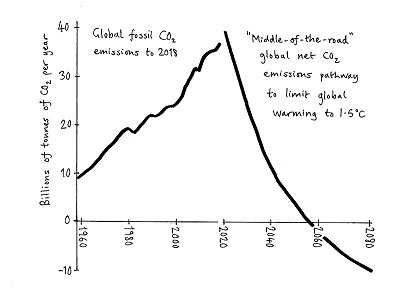Inadequate science communication risks enabling failure to limit climate change, writes Hugh Richards
Richards, H., Face facts on fossil fuels. Geoscientist 29 (11), 9, 2019
https://doi.org/doi: 10.1144/geosci2019-059, Download the pdf here

Is the UK geoscientific community about to miss a unique opportunity to make a substantive contribution to securing a stabilised Earth system with well below 2°C of global heating? I refer to the hosting in Glasgow in November 2020 of COP26 (arguably the most crucial UN climate summit thus far) and to the short time available for the UK to bring fresh thinking into what is currently a failing process. The Paris Agreement reached at COP21 willed ends, but not sufficient means; COP26 must rectify this. The graphic below illustrates the acute nature of this crisis.
Key questions with inaccessible answers
To my mind, the geoscientific community (working with other disciplines) should be able to give influencers and policy makers clear, accessible, best-endeavours answers to the following questions:
• How credible is it that the Earth system will (once past about 2°C warming) inevitably transition to a highly inhospitable ‘Hothouse Earth’ state within a century or two (as postulated by Steffen, W., et al. (2018) PNAS 33, 8,252-8,259;
https://doi.org/10.1073/pnas.1810141115)?
• In that context, how risky would it be to allow global warming to exceed 1.5°C?
• How much fossil carbon can still legitimately be extracted globally, without putting the Paris Agreement’s goal of ‘well below 2°C’ beyond reach?
• What would be an equitable apportionment between countries of such a global fossil carbon extraction budget? [Note that this is not the question addressed by McGlade and Ekins (2015) Nature 517, 187-190.]
• What is the feasible global capacity for carbon capture and storage (CCS), whether used to extend the global fossil carbon budget, to offset emissions from non-fossil sources or to draw down atmospheric CO2 levels?
• Which countries should be shutting down their fossil fuel extraction industries or effectively offsetting them with CCS?
• How easy would it be to monitor a ‘leave it in the ground’ (LINGO) treaty (or ‘fossil fuel non-proliferation treaty’) to control the extraction of fossil carbon (with or without offsetting by CCS)?
As we approach the end of the Society’s ‘Year of Carbon’, it seems that useable answers to these questions remain largely inaccessible to those who should need them. I suspect that such answers would be uncomfortable to many geoscientists, as well as to influencers and policy makers. I hope this is not why most of the above questions have not yet been seriously addressed.
In the absence of such information in readily accessible forms, the field remains clear for narratives that lack meaningful quantitative constraints. Once such is John Warburton’s Soapbox article (Geoscientist 29 (8), 9;
https://doi.org/10.1144/geosci2019-043), which somehow combines acceptance of the need for a ‘transition from our fossil-fuel addicted lifestyle’ with citing examples of only marginal reductions in CO2 emissions, and envisaging no prospect of an end to ‘the world’s insatiable thirst for a petroleum-based economy.’ At least this does implicitly recognise that demand reduction will not deliver global decarbonisation; hence the need for control of supply and extraction.
Leadership
At the other extreme are the supporters of Extinction Rebellion (XR), demanding UK net zero emissions by 2025. Although it pains me to say so, if humanity wants to limit global heating to 1.5°C with a reasonably high degree of confidence, with the UK playing an equitable role, the XR demand may not be so wide of the mark, and the UK should perhaps already have its fossil carbon extraction industries substantially offset by CCS. To commit to the latter course of action really would represent leadership on the international stage, and demonstrate what a ‘LINGO treaty’ might involve.
Do I think that such an outcome is likely? No, but if humanity is going to fail to avert ‘Hothouse Earth’, let it be primarily a failure of politics, not enabled in part by a failure of science communication.
Hugh Richards works in the UK civil nuclear decommissioning sector, but is here writing in a personal capacity.
An acute crisis

The graphic juxtaposes two curves that are rarely, if ever, seen together, let alone on the same time scale. They are not presenting quite the same parameter, but to an order of magnitude and to make the severity of the fossil carbon crisis clear, they might as well be.
In the interests of clarity and convenience, the graphic is hand-drawn, but is traced from impeccable sources. Past fossil CO2 emissions are from The Global Carbon Project’s report ‘Global Carbon Budget 2018’. The illustrative future net CO2 emissions pathway is ‘P3’ in Figure SPM3a&b of the Intergovernmental Panel on Climate Change special report ‘Global Warming of 1.5°C—Summary for Policymakers’.
Note the slight kink in the past fossil CO2 emissions curve around 2008. That is what a global economic ‘crash’ looks like, in terms of fossil carbon extraction.
Further reading
-
IPCC Special Report: Global Warming of 1.5°C—Summary for Policymakers
- McGlade, C. and Ekins, P. (2015) The geographical distribution of fossil fuels unused when limiting global warming to 2 °C. Nature 517, 187-190. https://doi.org/10.1038/nature14016
- Newell, P. & Simms, A. (2019) Towards a fossil fuel non-proliferation treaty. Climate Policy
- Richards, H. (2019) A ‘LINGO Treaty’ to control legitimately burnable fossil fuels at source?
- Steffen, W., et al. (2018) Trajectories of the Earth System in the Anthropocene. PNAS 33, 8,252-8,259
- The Global Carbon Project: Global Carbon Budget 2018
- Warburton, J., Petroleum geoscientists…wanted! Geoscientist 29 (8), 9, 2019; https://doi.org/10.1144/geosci2019-043